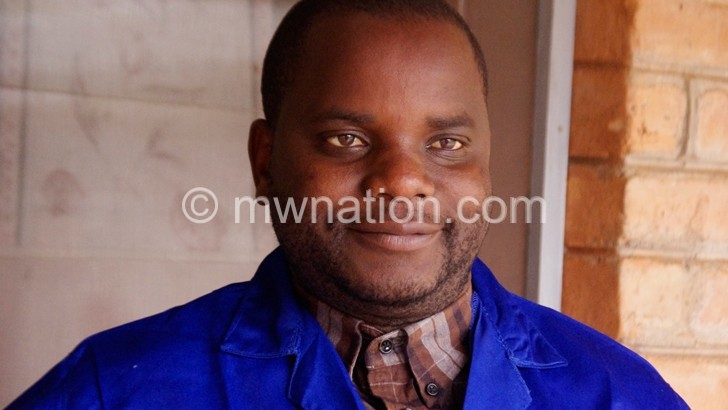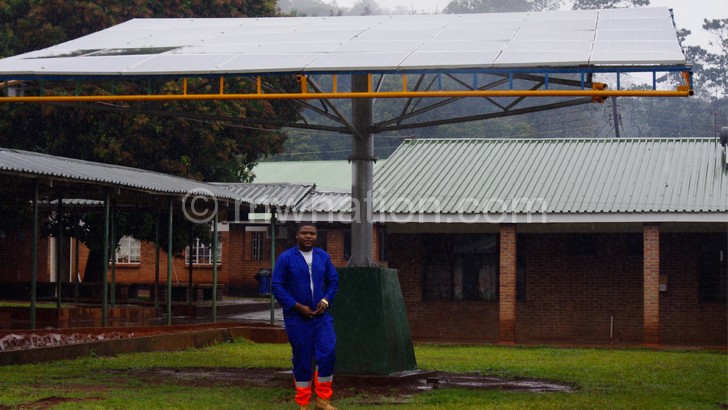Power of a solar tree
It was chilly when we arrived at Mulanje Boma, a small town at the foot of Mulanje Mountain. That rainy Friday, the highest peak in Central Africa—Malawi, Zambia and Zimbabwe—was draped in fog and the locals recalled not experiencing sunshine for a week.
But the wet weather did not dim health services at Mulanje Mission Hospital (MMH), where a solar tree recently installed by Sky Energy proclaims a silent shift towards the power of the sun to save lives.
“Come rain or sunshine, there’s enough sunlight to keep the hospital running. In fact, we are fully powered by solar right now. We no longer rely on the grid,” bragged Wilson Kachikuwa, the hospital’s electrical technician.
The man, wearing a blue work suit, was standing in the shade of the solar tree at the heart of the health facility owned by the Church of Central Africa Presbyterian (CCAP) Blantyre Synod. The tree, ‘leaved’ with 40 solar panels, adds 30 kilowatts to a hybrid power system once powered by the rooftop solar panels alone. The power being generated is stored by 46 solar batteries, partly recharged by the grid. Sixteen of these batteries have an in-built battery management system that detects and displays the amount of power stored.

Ending blackouts
With the upgrade, the hospital management envisages harnessing solar power to pump groundwater and run laundry machines.
This is the third phase of MMH’s switch to renewable energy.
For hospital director Ruth Shakespeare, tapping the power of the sun represents a life-saving game changer at the hospital where women used to give birth under candlelight or yellowish glows of kerosine lamps.
Long-serving health workers remember operating on women with birth complications in theatres using candles. Some newborns and mothers were dying in the dark, they say.
Not any longer. Memories of protracted blackouts and huge electricity bills are slowly fading amid multiple benefits of solar power.
Kachikuwa explained: “We don’t experience blackouts any more. We use solar power day and night. When Electricity Supply Corporation of Malawi [Escom] cuts power, health workers continue doing their life-saving work without any disruption, so the patients have no reason to complain.
“Previously, when power went off, we used to rush for candles and kerosine lamps which were exposing both patients and hospital workers to smoke and fumes which cause respiratory diseases.”
The power of the sun has also pushed diesel-powered generators out of the circuit. Near the control room, we saw a spider’s web in the exhaust pipe of a generator planted on the wayside.
“We haven’t run the gensets for months because the solar system has proved reliable,” he stated.
This way, the hospital has eliminated noise as well as carbon emissions that fuel air pollution and climate change.
The shift to renewable energy comes at a time government is switching to fossil fuels, especially coal and diesel-powered generators, to boost the national grid slowed by falling hydropower generated by turbines on Shire and Wovwe rivers.
Both coal and oil are major polluters discouraged by the Paris Agreement to save the planet from climate change.
MMH proves the renewables have the power to close energy gaps in health facilities excluded from the grid and those burdened by frequent blackouts.
Save for theatre and X-ray machines which require high power load, the whole hospital uses solar power.
“Soon we will replace the heavy-duty machines which need the grid, with digital technology powered by solar,” Kachikuwa indicated.

MMH is also home to a State-funded five-kilowatt solar power system to improve family planning and prevention of mother-to-child transmissions. This is part of a K2.7 billion project, funded by the Global Fund, in which the Ministry of Health has installed solar systems to ease power shortages in 85 health centres across Malawi.
However, such is the determination gaining sway at the second-largest hospital in Mulanje that the technician says it looks certain to go off-grid in the near future.
The solar tree is part of the shift which got off to an assuring start with installation of a life-saving unit powering oxygen concentrators, labour and children wards, children wing, kangaroo care section and corridor lights.
The mini-system was later expanded to the female and male wards, antenatal wing, theatres, laboratories, pharmacy and accounts and administration block.
“In the third phase, we are taking solar to a new level to run laundry machines and pump water for patients and health workers. The solar tree is the latest technology. It beautifies the setting and utilises small space to generate more power. It can be adjusted to derive maximum power when weather is unfavourable. Interestingly, the system at MMH has room for another solar tree,” said Sky Energy managing director Schizzo Thomson, who installed the system.
Water-energy nexus
The hospital is drilling boreholes where the solar-powered pumps will be installed to end water problems experienced by MMH workforce and patients in the dry season, especially in August and September when taps usually run dry.
However, clinicians are optimistic that the major gains will be registered in the hospital which sees 400 patients a day and delivers about 250 babies a month. The water woes compromise sanitation and hygiene among patients and guardians, they say. During the visit, surrounding communities had gone two weeks without tap water.
“All this will be history soon. Now we have the power for improved health service provision and increased access to safe water,” said Kachikuwa.





